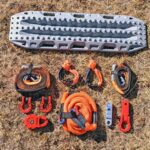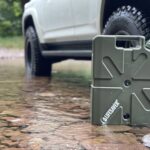Overlanding solo travel has grown in popularity among adventurers seeking freedom, self-reliance, and the thrill of exploring remote areas on their own. Traveling alone allows for an intimate connection with nature, the flexibility to follow your own schedule, and the satisfaction of managing every aspect of your journey independently. However, solo overlanding requires careful planning, the right gear, and strict adherence to safety measures. This comprehensive guide covers everything you need to know about solo overland travel, including preparation, gear selection, safety strategies, and practical tips to make your journey safe and enjoyable.
Introduction to Solo Overlanding
Overlanding is the practice of traveling long distances over land, often in self-sufficient vehicles, exploring off-the-beaten-path locations. When done solo, overlanding combines adventure with self-reliance, but it also presents unique challenges. Unlike group travel, solo overlanders must manage navigation, vehicle issues, emergencies, and personal safety alone. Understanding the benefits and challenges of solo travel is crucial:
Benefits of solo overlanding include:
- Complete freedom in planning routes and schedules
- Immersive experiences in nature and remote environments
- Opportunities for personal growth, resilience, and independence
Challenges of solo overlanding include:
- Limited immediate assistance in emergencies
- Increased need for planning and preparation
- Higher demands on mental and physical endurance
By carefully considering these factors and preparing appropriately, you can transform solo overlanding into a fulfilling and safe adventure.
Planning Your Solo Overland Adventure
Preparation is the cornerstone of safe and enjoyable solo overlanding. Effective planning encompasses route selection, scheduling, and emergency preparedness.
Route Planning & Navigation
A well-planned route minimizes risks and ensures you reach your destinations safely. Key considerations include:
- Choosing safe and scenic routes: Research routes suitable for solo travel. Avoid areas with high crime rates or unreliable access to resources. National parks, well-maintained off-road trails, and less-traveled scenic roads are excellent options.
- Navigation tools: Invest in GPS devices, offline mapping apps, and physical maps. Tools like Gaia GPS, Maps.me, and AllTrails provide reliable offline navigation.
- Terrain and weather analysis: Assess terrain difficulty and weather conditions. Avoid high-risk areas like unstable river crossings or steep, unmarked trails during the rainy season.
Scheduling & Timing
Proper timing can make a significant difference in a solo overland trip. Consider these points:
- Best seasons: Select seasons with favorable weather to reduce hazards. Spring and autumn often provide mild temperatures and safer road conditions.
- Overnight stays: Identify campsites or safe rest points in advance. Prioritize locations with water access and emergency support nearby.
- Resource estimation: Calculate fuel, water, and food requirements based on distance, terrain difficulty, and vehicle fuel consumption.
Emergency Planning
Being prepared for emergencies is non-negotiable for solo overlanders:
- Communication: Share your planned route with family or friends. Schedule regular check-ins.
- Medical preparation: Carry a comprehensive first aid kit, essential medications, and knowledge of basic first aid.
- Mechanical contingencies: Include tools, spare tires, and repair kits. Know how to perform basic vehicle maintenance.
Essential Gear for Solo Overlanding
Proper gear is the backbone of a successful solo overland adventure. Prioritize vehicle equipment, camping essentials, and personal gear for safety and comfort.
Vehicle Equipment
The vehicle is your lifeline on the road. Equip it with:
- Recovery gear: Include a winch, recovery straps, and traction boards. This equipment is essential for solo off-road recovery.
- Spare tires and tools: Carry at least one spare tire, tire repair kits, and tools for basic repairs.
- Vehicle maintenance kits: Include engine oil, coolant, and essential lubricants to prevent breakdowns.
Camping & Survival Gear
Solo overlanders must be self-sufficient in remote locations. Essential camping and survival items include:
- Tents and sleeping gear: Invest in a high-quality tent suitable for solo camping. Consider weather-resistant sleeping bags and portable sleeping mats.
- Food and cooking setup: Bring lightweight stoves, portable cookware, and sufficient non-perishable food. Check out Overlanding Kitchen Setup & Camp Gear for ideas.
- Water storage and purification: Carry ample water and portable filtration systems to ensure safe drinking water.
- Lighting and safety equipment: Headlamps, lanterns, reflective markers, and first aid kits are essential for night safety and emergencies.
Personal Gear
Personal items ensure your comfort, safety, and health during solo overlanding:
- Clothing: Pack weather-appropriate clothing, including thermal layers, rain gear, and durable footwear.
- Navigation and communication devices: Satellite phones, personal locator beacons (PLBs), and GPS devices improve safety in remote areas.
- Health and hygiene: Include toiletries, sanitation kits, sunscreen, and insect repellents.
Essential Solo Overlanding Gear Table
| Gear Category | Items |
|---|---|
| Vehicle Recovery | Winch, recovery straps, traction boards, spare tire, tools |
| Camping Gear | Tent, sleeping bag, sleeping mat, portable stove, cookware |
| Water & Food | Water storage, filtration system, non-perishable food, snacks |
| Lighting & Safety | Headlamp, lanterns, reflective markers, first aid kit, fire extinguisher |
| Navigation & Communication | GPS device, maps, satellite phone, personal locator beacon (PLB) |
| Clothing & Personal Gear | Thermal clothing, rain jacket, sturdy boots, hygiene supplies |
Solo Overland Safety Tips
Safety is the most critical aspect of solo overlanding. From driving to campsite precautions, these tips minimize risks and enhance your confidence.
On-Road Safety
Driving alone in remote areas presents unique risks:
- Vehicle checks: Inspect tires, brakes, lights, fluids, and recovery gear before departure.
- Avoiding risky terrain: Do not attempt river crossings or steep inclines without prior experience or proper equipment.
- Safe driving practices: Drive at safe speeds, maintain situational awareness, and always have an alternate route in mind.
Camp & Wildlife Safety
Camping safely ensures a stress-free solo experience:
- Campsite selection: Choose elevated, dry areas away from animal trails or flood-prone zones.
- Wildlife precautions: Store food securely, avoid attracting animals, and learn basic wildlife deterrence techniques.
- Fire safety: Follow local regulations, use designated fire pits, and extinguish fires completely.
Personal Safety Strategies
Protecting yourself while traveling solo is essential:
- Communication: Maintain regular check-ins with trusted contacts.
- Self-defense awareness: Be vigilant, avoid dangerous areas, and carry safety devices like whistles or pepper spray where legal.
- Emergency signaling: PLBs, flares, or satellite communication devices ensure help can reach you in case of serious incidents.
Nutrition & Hydration on Solo Trips
Food and water management is vital for energy and endurance:
- Meal planning: Choose meals that are nutritious, easy to prepare, and lightweight. Freeze-dried meals, canned goods, and high-protein snacks are ideal.
- Hydration: Calculate daily water needs and carry sufficient reserves. Portable filtration and purification methods add safety.
- Cooking tips: Use simple recipes to save time and energy while maintaining nutritional balance.
Solo Overlanding Pre-Trip Planning Checklist Table
| Task Category | Key Actions |
|---|---|
| Route & Navigation | Plan route, download offline maps, identify safe campsites, check terrain |
| Vehicle Prep | Inspect tires, brakes, fluids, recovery gear, fuel reserves |
| Gear Packing | Pack camping gear, cooking supplies, clothing, personal items |
| Emergency Prep | First aid kit, communication devices, inform family/friends of itinerary |
| Nutrition & Hydration | Food planning, water storage, cooking equipment |
| Safety Measures | Wildlife precautions, fire safety, self-defense tools |
Solo Overlanding Best Practices
Efficient routines and careful management enhance both safety and enjoyment:
- Daily checklists: Monitor vehicle condition, fuel levels, and weather conditions.
- Health maintenance: Ensure proper rest, hydration, and nutrition. Stretch regularly to prevent fatigue.
- Environmental responsibility: Respect local regulations, avoid littering, and minimize ecological impact.
Common Mistakes & How to Avoid Them
Avoiding common errors improves the overall solo overlanding experience:
- Overpacking or underpacking: Strike a balance between essential gear and portability.
- Ignoring terrain and weather conditions: Plan for contingencies and adapt to environmental changes.
- Neglecting safety and emergency planning: Always prepare for worst-case scenarios; your life may depend on it.
FAQs About Solo Overlanding
What is the best gear for solo overlanding?
The best gear includes a reliable vehicle, recovery equipment, quality tent and sleeping gear, cooking supplies, water filtration, GPS/navigation devices, and personal safety items.
How to stay safe while traveling alone?
Stay safe by planning routes meticulously, sharing your itinerary, carrying emergency communication devices, and practicing situational awareness at all times.
Can I solo overland in remote areas?
Yes, but ensure proper planning, reliable gear, and emergency measures. Avoid areas without connectivity unless you have satellite communication.
How do I plan a route for solo off-road travel?
Research trail difficulty, terrain, weather conditions, and campsite availability. Use GPS and offline maps, and plan alternate routes for emergencies.
Conclusion & Call to Action
Overlanding solo travel is an exhilarating way to explore remote landscapes, gain independence, and enjoy personal freedom. By following the guidelines outlined in this article—careful planning, equipping the right gear, and prioritizing safety—you can maximize enjoyment while minimizing risks.
Prepare thoroughly, respect the environment, and maintain constant vigilance, and your solo overland adventure can be both safe and unforgettable.
Ready to embark on your solo overlanding journey? Consult our guides, pack strategically, and start planning today. Your safest and most rewarding adventure begins with preparation.








